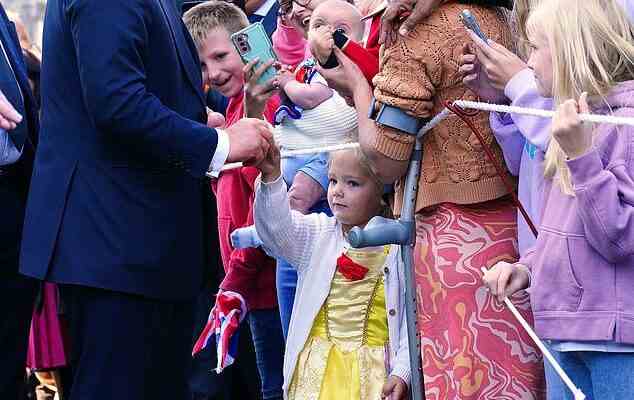Michael Sheen says the King and Queen Consort’s recent visit to Wales could be seen as ‘insensitive to the point of insulting’.
Charles, 73, and Camilla, 75, completed their four nations tour with a stop in the country yesterday.
But according to the actor, as the visit fell on an important historic date, it could be seen as ‘insensitive’ if the royals chose that date on purpose.
September 16 marks Owain Glyndŵr day. The same day in 1400 is when Glyndŵr began a 15-year uprising against the then-king of England, Henry IV, after which his followers would proclaim him Prince of Wales.
King Charles (pictured) met members of the public as he left Cardiff Castle yesterday while in Wales as part of his tour of the four nations

Actor Martin Sheen (pictured) noted that the visit by the new King and Queen Consort could be seen as ‘insensitive’ as it fell on September 16 – an important historic date for Wales
The revolt is considered to be the last Welsh war of independence and Glyndŵr has since been viewed as a figurehead of Welsh nationalism and the independence movement.
Normally, thousands celebrate the life and legacy of the ‘rebel’ Prince of Wales.
However, following the death of Queen Elizabeth II, a number of Glyndŵr day events were cancelled, prompting disappointment and anger in some communities, with some hosting their events.
Michael Sheen took to Twitter, sharing a video with his thoughts on the visit.
In it, he said that it was a ‘beautiful day in Wales’, and also a very important one ‘for a number of reasons’.
He explained that it marked the first time King Charles was visiting Wales since the death of Queen Elizabeth.

King Charles III was seen meeting schoolchildren following a service of prayer and reflection for the life of Queen Elizabeth at Llandaff Cathedral in Cardiff on Friday
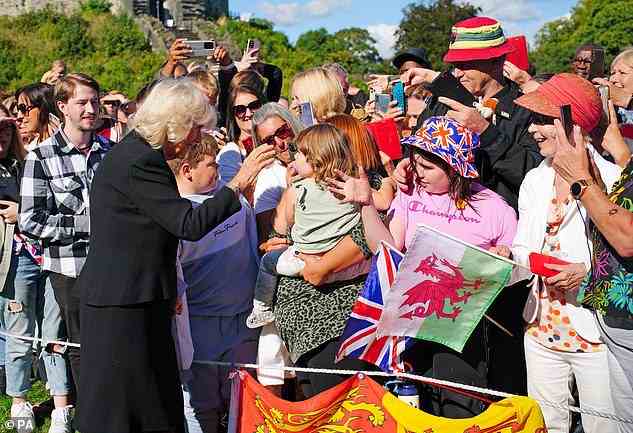
The Queen Consort meeting members of the public who cheered as she and the King did a walkabout as she and her husband left Cardiff Castle in Wales
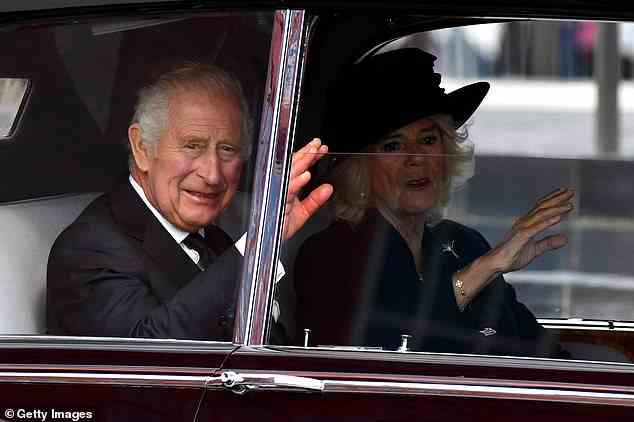
King Charles III and Camilla, Queen Consort waved as they arrived to receive a Motion of Condolence at the Senedd in Cardiff today
Describing the period of time since her death at Balmoral, he said it had been ‘extraordinary’ and ‘very ’emotional’, an ‘era defining period of time’.
‘I offer my sincerest sympathy to Charles and his family on the loss of their mother, grandmother, and to everyone who’s feeling such depth of emotion and a sense of that loss,’ he said, noting that Her Majesty had been a ‘fixed point’ for so many people.
However, he noted, there ‘is more than one story in these isles. There is more than one tradition, there is more than one history.’
The actor explained: ‘September 16 is the day that many people here in Wales celebrate Owain Glyndŵr, who was the last native Prince of Wales, self-proclaimed’.
Glyndŵr led a rebellion against the English crown in 1400, to ‘not only to free his nation but to create his nation’, Michael explained.
He added: ‘[The rebellion] was eventually crushed, and that was the last time Wales had a native Prince of Wales.’
The tradition of naming a Prince of Wales was started by King Edward I, who named his son Prince Edward Prince of Wales, in a move Michael described as ‘a sort of symbolic act of rebuke or punishment and humiliation’.
‘And so this day, September 16, is important to many people in Wales,’ he said.
‘Because it marks the moment where Glyndŵr claimed the title of the Prince of Wales again’.
So, he said, the two things – the King’s visit and Owain Glyndŵr day – are ‘clearly connected’.
Michael explained: ‘To choose September 16 to come to Wales having only a short time ago proclaimed that he had created his son William as the new Prince of Wales and to choose this day September 16 to come here as his first visit as King seems full of meaning.’
If it had been done purposefully, he added, it could seen as ‘insensitive to the point of insulting’.
He continued: ‘If it was done without realising the significance of the date, then one does wonder what being Prince of Wales for so long actually meant if you’re not aware of what that day means.’
He added he wanted to add his voices to those of others who were noting the ‘irony’ of traditional Welsh celebrations being cancelled to accommodate an English monarch visiting.
‘I hope it’s not a declaration of intent, because that would be very concerning,’ he said.
King Charles announced last week that Prince William, 40, and his wife Kate Middleton, 40, would become the new Prince and Princess of Wales.
The royal couple released a statement following the announcement in which they spoke of their ‘deep affection’ for Wales, having made their first family home in Anglesey.
They promised to carry out the role with ‘humility and great respect’.
But some were unhappy with the decision, and a petition calling for an end to the title out of ‘respect’ for the Welsh has since gathered more than 25,000 signatures.
The page quoted Michael Sheen, who returned his OBE in 2017 and said about the title: ‘Don’t necessarily just because of habit and without thinking just carry on that tradition that was started as a humiliation to our country.
‘Why not change that as we come to this moment where things will inevitably change?’
However, over the years, opinion polls suggest the majority of people in Wales are in favour of having a prince.
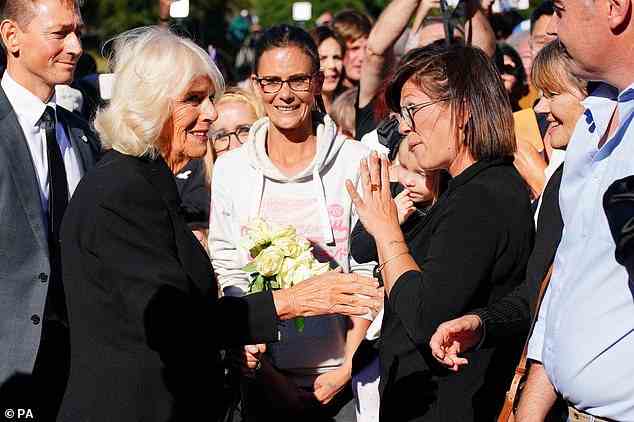
The Queen Consort and King Charles had a warm reception in Cardiff yesterday where they met and chatted with members of the public
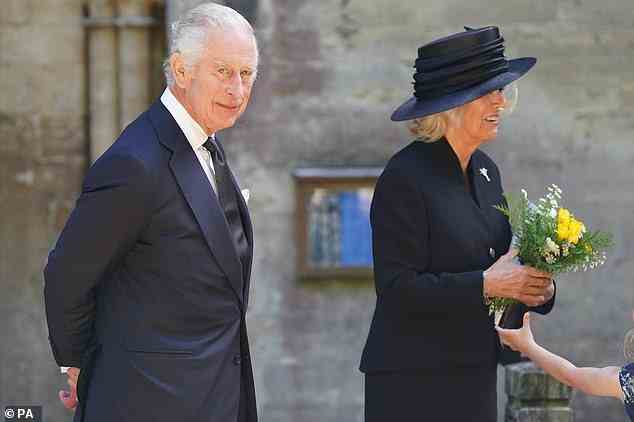
King Charles and the Queen Consort leave Llandaff Cathedral in Cardiff, following a service of prayer and reflection for the life of the Queen
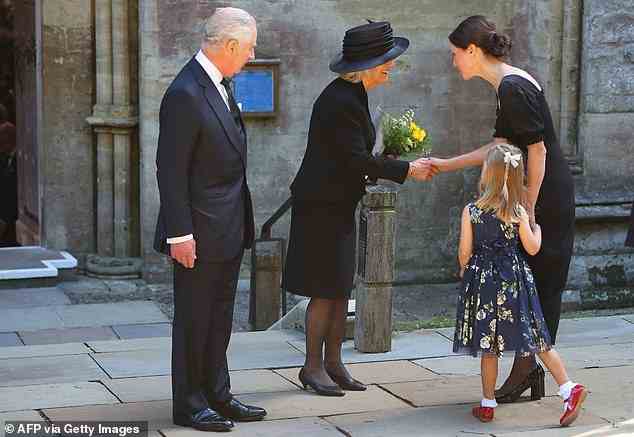
A little girl gave the Queen Consort a bouquet of flowers outside Llandaff Cathedral yesterday after King Charles arrived in Wales for the first time as monarch
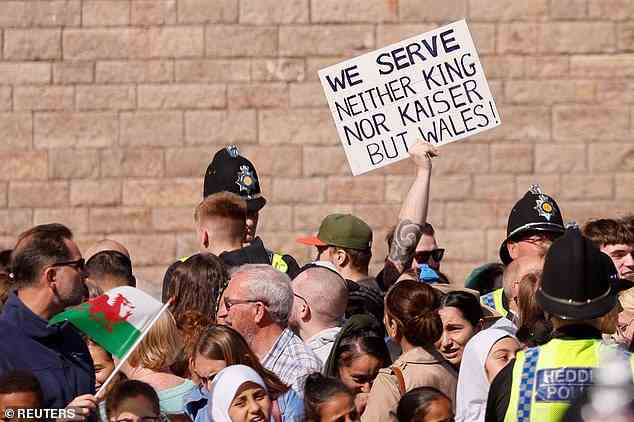
A demonstrator holds up an anti-monarchy sign outside Cardiff Castle as King Charles arrives during his first visit as monarch
During the visit yesterday, King Charles was cheered by thousands of fans, showed off his Welsh language skills and even spoke to a goat mascot during what was considered to be a successful first trip to the country as monarch.
The King was joined by the Queen Consort as he first attended a service of remembrance for his mother the Queen at Llandaff Cathedral in Cardiff, where he was joined by the Prime Minister Liz Truss and Welsh first minister Mark Drakeford.
The congregation sang Welsh hymns including the much-loved Guide Me O Thou Great Redeemer.
Meanwhile, the Archbishop of Wales said in a tribute how the Queen ‘had the ability to relate to the man or woman on the Clapham Omnibus, or here, the Merthyr Tydfil Omnibus’.
In what was a packed day, Charles and Camilla went on to be greeted by school children and thousands of other Royal fans, before he gave a speech in Welsh to the Senedd and spoke of how close Wales was to his mother’s heart.
Charles said in his speech in the Senedd: ‘I am deeply grateful for the words of condolence which so movingly paid tribute to our late sovereign, my beloved mother The Queen.’
The King continued: ‘Through all the years of her reign, the land of Wales could not be closer to my mother’s heart.
‘I know she took immense pride in your many great achievements, even as she also felt you deeply in great times of sorrow.
‘It must surely be counted the greatest achievement to belong to a land that inspired so much devotion.
‘I am resolved to honour that same example in the spirit of the words I always try to live my own life – Ich dien – I Serve.’
The King went on: ‘I take up my new duties with immense gratitude for the privilege of having been able to serve as Prince of Wales.
‘That ancient title dating from the time of those great Welsh rulers… I now pass to my son William whose love for this corner of the Earth is made all the greater by the years he himself has spent here.’
The final stop was Cardiff Castle.
There, he had a private meeting with Mr Drakeford and then had a chance encounter with Sheinkin IV, the goat mascot for the Royal Welsh Third Battallion.
Team GB legend Dame Tanni Grey-Thompson was one of those invited to welcome the King at the castle.
She said the ceremony was ‘about looking back at the life of her majesty in terms of service and devotion but also looking forward to the future.’
‘We have a new king and perhaps a new way of doing things. It’s a chance for society to think about what we want from our monarchy.’
After shaking hands with fans who flocked in their thousands to greet their new king, Charles and Camilla departed for the royal helicopter, which flew them to London.
Amid the cheering that arose as Charles and Camilla arrived by motorcade at Cardiff Castle following their visit to the Senedd, anti-monarchy protesters could be heard booing while holding signs reading ‘We want a democracy, a Welsh republic’.
Despite intending to be a silent protest by a number of groups under the banner Real Democracy Now, the rally also at times broke into song led by members of the Cor Cochion, a socialist choir based in Cardiff.
A representative for Michael Sheen has been contacted for comment.

